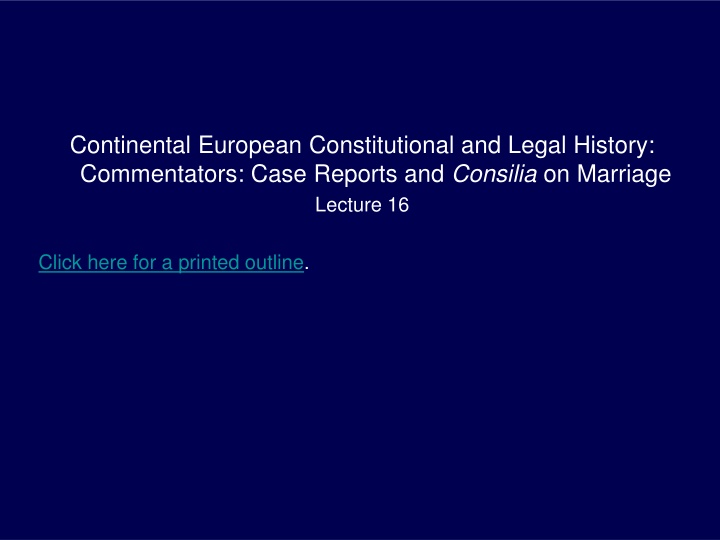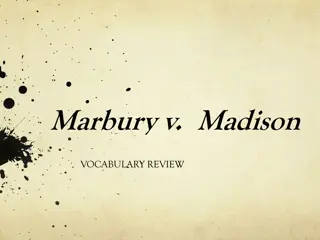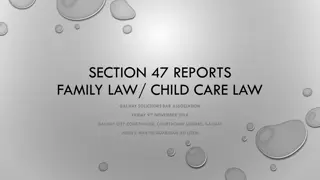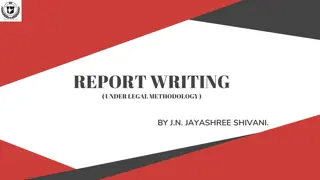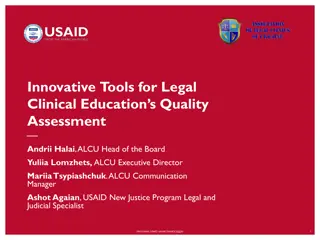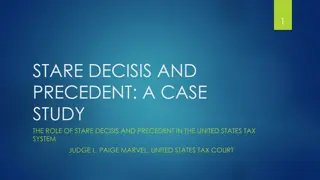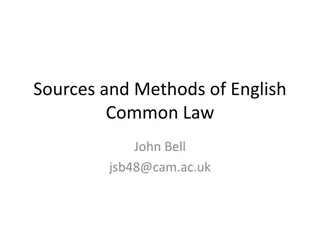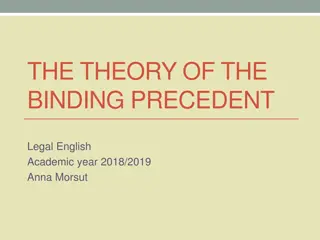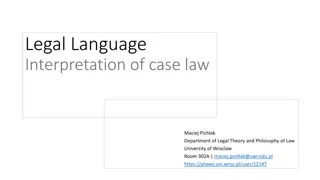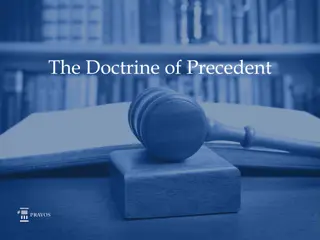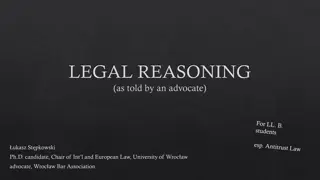European Legal History: Precedent and Case Reports
Explore the evolution of case reporting and precedent in Continental European legal systems, highlighting the similarities and differences with Anglo-American common law. Discover how academic commentary and case material influence legal development on the European Continent.
Uploaded on Sep 14, 2024 | 0 Views
Download Presentation

Please find below an Image/Link to download the presentation.
The content on the website is provided AS IS for your information and personal use only. It may not be sold, licensed, or shared on other websites without obtaining consent from the author.If you encounter any issues during the download, it is possible that the publisher has removed the file from their server.
You are allowed to download the files provided on this website for personal or commercial use, subject to the condition that they are used lawfully. All files are the property of their respective owners.
The content on the website is provided AS IS for your information and personal use only. It may not be sold, licensed, or shared on other websites without obtaining consent from the author.
E N D
Presentation Transcript
Continental European Constitutional and Legal History: Commentators: Case Reports and Consilia on Marriage Lecture 16 Click here for a printed outline.
Introduction In the last lecture we looked at a case decided by the Roman Rota in 1574. In this lecture I want to go back to the period of the commentators and look at a case decided in the Rota in the fourteenth century and at two consilia by the fifteenth-century canonist Panormitanus. Both the Rota case and the consilia deal with marital property, and these cases will give us a springboard to offer some thoughts on the topic of marriage in the period of the commentators. First, however, we ought to say a few a words about cases and case-reporting on the European Continent.
Cases and case reports on the European Continent Traditionally, it is said that one of the big differences between Continental civil law and Anglo-American common law is that is that in the Anglo- American common law cases decided by judges are authoritative but on the Continent only the codes are authoritative, and that academic commentary on the codes takes the place of cases in the Anglo-American tradition. Indeed, it is sometimes said that the civilians have no doctrine of precedent. It turns out that that is only partially true. In the first place, our doctrine of precedent, to the extent that we still have it, is not very old an 18th century development that does not become a formal doctrine until the 19th century. That one should respect precedents, of course, goes a long way back but that is quite different from a doctrine of binding precedents. Secondly, it is a considerable exaggeration to say that modern civilians do not respect precedent. They do. One has only to look at the way in which the French courts in the 19th developed a modern doctrine of wrongs caused by negligence out of seven singularly unhelpful provisions in the Napoleonic code or at the way in which the German Constitutional Court operates today to see that case material is authoritative on the Continent and that it plays a role in the development of the law.
Cases and case reports on the European Continent (contd) It should not, therefore, be surprising if I tell you that for the period before the codes, the attitude toward precedent in both the civil law systems and in the common law was quite similar. Further, it is striking how the civil-law jurisdictions began to publish case reports at approximately the same time that the English began to publish them, the late 13th century for England and fairly early in the fourteenth for Roman Rota. We ll be looking at one of those cases later in the lecture. In some jurisdictions these case reports are very extensive indeed. I am thinking particularly of Italy where the publication of reports of cases of secular courts continued well into the 18th century. We ll be looking at one such case in the next lecture. It is perhaps not by chance that some Italian courts seem to have developed in the 18th century a doctrine of precedent like that which English courts were developing, and at approximately the same time.
Cases and case reports on the European Continent (contd) One reason that the later middle ages pay increasing attention to case material is that the records get better. Another reason, perhaps, is a sense that what is done in reality has a bite to it that cannot be captured in a moot or a quaestio disputata. (We ve already seen that the latter is characteristic of the educational system already in the time of the glossators.) For whatever reason, the publication not only of case reports but also of consilia became a major source of legal literature on the Continent. Consilia are not quite the same thing as decided cases. They are written by jurists and not by judges. Most of them, however, seem to be concerned with real facts rather than hypothetical ones. In the 14th and 15th centuries many jurists published their consilia, and the consilia of respected jurists, some running to many volumes, became an important type of printed legal literature in the late 15th and 16th centuries. Later in the lecture, we will look at two such consilia by the 15th-century canonist Panormitanus on the topic of marital property. .
Cases and case reports on the European Continent (contd) A story that is not well known: Most of the focus on the comparative legal history of England and Europe has been on finding or not finding Continental influence on the development of English common law. This may be an example where it worked the other way. In the late 1260s the lawyers in the central royal courts in England began recording the debates that took place before the courts. The reason that they did this was that the record only reported pleas that were actually made and judgments, and much that was interesting happened in pleas that were proffered and discussed but never made. These reports of cases are known as Year Books. The first continental reported cases are those of the Roman Rota, and they come from the 1330s rather soon after the Rota gets going. It is well known that English canonists sat as auditors of the Rota. The first collection of decisions of the Rota is associated with the name of Thomas Fastolf (of the famous Falstaff family of East Anglia), who was auditor of the Rota, from 1340 1352, but his collection of decisions covers a brief period in 1336 37, when he was a lesser judge of the Rota, listening to the arguments of the auditors. What has just been discovered is that Thomas s older brother, Nicholas, was a serjeant of the central royal courts. It seems at least plausible that the idea of collecting Rotal decisions occurred to Thomas because that form of legal literature was such an important part of his brother s professional career.
Cases and case reports on the European Continent (contd) The way that Thomas and his successor Bernardus de Bosqueto report Rota decisions is not the same as the way that Year Book cases are reported. That s not surprising, considering the difference in procedure of the two courts. There is also something curious about decisions of the Rota. There is a quite extensive collection of them for the 14th century, and a very large number of them for the 16th century. The series continues to this day. There are, however, none printed for the 15th century, and the man who is looking for manuscripts (and has found a number of unprinted 14th century reports) has found none for the 15th century. That s a puzzle for which no one yet has an answer.
Decision (Holy Roman Rota, 1360 X 1365) The decisions in the materials are typical of the Rota decisions. The one we re going to look at now, the case of Anna the widow of Peter, was decided by the Rota sometime between 1360 and 1365. I put the case in the materials with malice aforethought because it illustrates quite nicely a point that is frequently made about the development of the law of marital property in the later Middle Ages, particularly in southern Europe: as the Middle Ages wears on, dowry law in southern Europe becomes more favorable to the man and his family and less favorable to the woman and hers. We don t know where the case comes from, but in the case it is assumed that we are dealing with a dotal system. As is so often the case, the way the facts are characterized is key. It is also characteristic of these decisions, as it is of Continental decisions today, that less attention is paid to the facts. So let s see what we can do to smoke out the facts.
Decision (Holy Roman Rota, 1360 X 1365) (contd) Peter has made his wife the testamentary tutor of their children with benefit of inventory. This means that she can make an inventory of what is theirs and will be held responsible only for what is in the inventory. The issue is what to do about property that she argues is hers because (1) he gave it to her, or (2) she acquired it during the marriage by her own efforts, or (3) her husband s relatives and friends had given it to her. These three issues lead to four holdings: First, It seems that it ought to be said that he did not seem to give them to her, because the necessity of supporting and administering such things for her falls on the husband, and therefore the laws favor the husband, so that he is understood to have handed them over to her only for current use [citing D.24.1.31, D.24.1.53.1, D.24.3.66.1, D.24.1.31, Oldradus and Cynus.] In other words, the husband should not be presumed to have given a gift because he has the responsibility to maintain the wife. (Think about this argument. Does it work?)
Decision (Holy Roman Rota, 1360 X 1365) (contd) Second, So far as what was acquired by her industry and diligence is concerned, it seems that it ought to be said that if they were acquired by her efforts [operis], they ought to pertain to the husband or to the man and his heirs after him, because the wife is held to work for the husband [citations to the Digest, Code, and the 13th-cetnury canonist Sinibaldus Fliscus, all of which are easily distinguishable]. If however she acquires other things otherwise and can show whence and from whom or in what way, then they ought to pertain to her and not to the husband, even if she acquired with the money of the man, for example, in trading or in keeping it in the bank [citation to the Digest]. For the woman is free, except as to the carnal debt and working [citation to the Code]. In short, what the wife has obtained through her labor belongs to the husband. What she obtains through investments is hers.
Decision (Holy Roman Rota, 1360 X 1365) (contd) Third, So far as the vessels and jewels and clothing and other ornaments are concerned, which of necessity the man is not held to minister to her, if it appears that they were handed over to her with the intention of making a gift, although the gift is not valid, as one made between husband and wife, then, because the husband did not expressly revoke it, I would say that it was confirmed by the death of the man, and that they ought to pertain to her and not to the heirs of the husband [citation to the Digest]. But in the aforesaid case of handing over, I do not believe that by these words which the husband said to the wife, You may hold this , he seems to have made a gift, but rather that she keep it and to commend it to her use indiscriminately, because in a doubtful matter someone is not presumed to have made a gift nor to have cast aside what is his [citations to the Digest] especially lest in so presuming they despoil themselves by mutual love, and because a gift between husband and wife is prohibited by law, and in a doubtful matter one is not presumed to have done something against the disposition and prohibition of law. Once more, the husband should not be presumed to have made a gift to his wife, particularly because it s illegal for him to do so.
Decision (Holy Roman Rota, 1360 X 1365) (contd) Fourth, So far as the other things given to the wife by others with the man looking on are concerned, I believe that a distinction ought to be made, whether these intended chiefly to give to the man and wanted them to be his acquests, although they handed them over to the wife, and then I believe that such things ought to pertain to the man and to his heirs and not to the wife . . . . If, however, those who gave to the wife with the man looking on intended principally to give to the wife, and they wanted the things given to be acquired by her and not by the man, although they did this with him looking on, then I would believe that such gifts were acquests of the wife and not of the man, for she is a free person who can acquire for herself, nor are they acquired for him, because they are not acquired by her efforts [citation to Cynus]. . . . In a doubtful case I would believe that recourse must be had to conjecture and to the type of thing given, whether it is more fitting for a man than for a wife and vice versa, so that according to this it may be presumed whether the givers wanted it to be acquired by the man or by the wife. . . . In short, what was given her by others depends on to whom they intended to give it, and it is not to be presumed to be given to her unless it was suitable for her.
Decision (Holy Roman Rota, 1360 X 1365) (contd) Following these holdings, there s a piece of advice: And therefore it would be safer for the wife to put everything in the inventory, protesting her right that on account of this she does not intend to confess that these things pertained to the husband or his heirs or ought to pertain, and protesting that the things appear to pertain to her by right, as she wishes to obtain her own things, lest without protestation by simply placing them in the inventory she might seem to confess that they pertained to the man or to his heirs or ought to pertain [citation to the Code], which she will not seem to confess with the aforegiven protestation which will keep her right for the future. [Citations to the Digest, the Liber extra, the Sext, and the 14th-century canonists Johannes Monachus and Johannes Andreae] In short, the practical advice is put it in the inventory with a protest and argue the case out later.
Decision (Holy Roman Rota, 1360 X 1365) (contd) I think its fairly clear from the citations of the authorities (some of which are given in the footnotes in the Mats.) that neither the Roman-law texts nor the canon-law texts require this result. In particular, Roman law, with its strict separation of property, did not presume that what was gained through the efforts of the wife belonged to the husband. One thing that helps in explaining the Roman texts is the prohibition against gifts between husband and wife. The rule, however, did not apply to legacies, which is why it is important that the husband didn t mention the property in question in his will. The rule also did not apply, in what was more a medieval rule than a Roman one, if the husband made a gift and then did not revoke the gift before his death. I think it s fair to say that this case illustrates a tendency to move the law of marital property in the direction of male control, though there s still some maneuvering room for the woman and her family if they are persistent and keep good records.
Marriage in the commentators The commentators on marriage have not received a very good press. The basic scheme had been fixed by the canon law at the beginning of the 13th century by Alexander III and Innocent III. The problem was to return in the 16th century in ways and for reasons that we will see, and much needed to be done in individual cases as have already seen, but little, the traditional view is, that the commentators taught about marriage is of much interest. As we just noted, there is more development in the area of marital property. The civilians having abandoned the field of the formation of marriage to the canonists spent some time adapting the Roman system of dowry to the conditions of the middle ages. By and large in this period southern Europe, with the exception of Spain, became a region of dowries; women were largely excluded from control of marital property, and male control became the norm. Male control also became the norm in northern Europe as well, but there the tradition of dower, prestation by the man or his kin, and of community property was much stronger.
Marriage in the commentators (contd) It has recently been suggested, however, that quite a bit happened with the regard to marriage during the period of the commentators. The most extreme version of the argument goes something like this: Marriages may be made by consent in canon law, but in the practice of the people they were made by intercourse. Gratian had it closer to right than did Alexander III. Over the course of the 14th and 15th centuries, so the argument runs, this popular notion of marriage penetrated into the ius commune. We don t see it in the formal treatments of marriage, because there the canon law prevails, but we do see it in side remarks about marriage and particularly in the consilia about dowry, where it became the common opinion of the doctors that a man was not entitled to a share of the dowry of his predeceased wife unless they had consummated the marriage.
Marriage in the commentators (contd) I think this view is mistaken, though I am willing to concede that the commentators do, on occasion, deal with the problem of the dissolubility of unconsummated marriages, a topic which you may recall that Alexander left in something of a muddle. What is going on in the area of marital property, however, at least in my view, illustrates a somewhat different point. Let s take a look at a couple consilia of Panormitanus.
Panormitanus on marriage Panormitanus = Nicol de Tudeschi (Panormitanus) (b. at Catania, Sicily, in 1386; d. at Palermo, Sicily, 24 February 1445). In 1400 he entered the Order of St. Benedict; he was sent (1405 6) to the University of Bologna to study under Francesco Zabarella, the most important Italian canonist of the day. In 1411 Panormitanus became a doctor of canon law, and taught successively at Parma (1412 18), Siena (1419 30), and Bologna (1431 32). In 1425 he became the abbot of Maniacio, near Messina in Sicily. Hence, he is frequently called abbas modernus (to distinguish him from Bernardus de Montemirato, abbas antiquus, a decretalist who died in the late 13th century). In 1435 Nicol became the archbishop of Palermo, hence, Panormitanus. Panormitanus relationship with conciliarism is interesting and complicated. It is explored in some recent literature. The following consilia, however, are unrelated to conciliarism.
Panormitanus on marriage: consilum Stante statutto There is a statute that provides that a man is enriched with a third part of his wife s dowry if she dies before him without children, if a man leads a wife to his house and lives with her or goes to live with her. It is asked if he who led a wife by words of the present tense and brought her to the house of his usual habitation and had her there in his family enjoys the benefit of the statute, the aforesaid consort or spouse dying in the house of the same man before the marriage was consummated by carnal coupling. What is the statute all about? I think that what the makers of the statute were saying is that if a marriage has been consummated, the husband is entitled a third of the wife s dowry if she dies childless. The Roman law texts do not talk about intercourse but about the deductio in domum, the leading of the bride to the house of the groom. This the early glossators had interpreted as equivalent to the intercourse that Gratian was requiring in order to make a marriage complete. Of course, by Panormitanus time the story had gone much further than that. Under Alexander s rules it s present consent that makes a marriage. You should read through the consilium carefully (Mats., p. XIV 12) but with some oversimplification the arguments can be boiled down to the following:
Panormitanus on marriage: consilum Stante statuto (contd) [1.] It seems first that not: because the statute makes mention of a wife and husband, but the name wife and husband sometimes is understood to be only those who have consummated the marriage by carnal coupling. Panormitanus concedes that this is the case, but notes that Mary and Joseph were truly husband and wife and argues that the statute cannot be taken to apply only to those who had consummated their marriage because it uses the word wife to apply to a woman who has not been led to the man s house or before he goes to live with her. [2.] The statute requires three things: (a) That the woman be a wife, (b) that the woman was led to the house, and (c) that she have lived with her husband. All of these requirements are met in this case.
Panormitanus on marriage: consilum Stante statuto (contd) [3.] There cannot be assigned any good reason to the law unless it be that the husband in sustaining the burdens of the marriage incurs many losses, and although he has dowry for supporting them, the expenses for clothing and ornaments are so great that the dowry is consumed in them. The husband, Panormitanus tells us, had prepared, as I hear, much clothing, and had made many preparations, so that he might consummate a marriage with a wedding feast with her with the usual solemnity. He ought therefore to enjoy the benefit of the statute, since the words and the natural mind of the statute persuade. If the statute means what I think it means, then Panormitanus makes it mean something else. He does this because he assumes the basic scheme of canon law, which is also, on this topic, the ius commune. Of course, they are husband and wife. Why because canon law and Roman law say they are. In this respect the two laws are not different, and together they make up the ius commune.
Panormitanus on marriage: consilum Stante statuto (contd) Panormitanus even attempts to find the policy of the statute. Where does that come from? It comes, he says, from the notion that the husband should be recompensed for his expenditures in supporting the wife. And, as he is told, that in fact is what happened in this case. But although P. may do a good job in deciding this case he does a bad job with the statute. For as he himself points out, it s a little odd that the statute also applies if the husband went to live with the wife, where we need not assume that the husband has incurred expenses in maintaining his wife. If we assume that the statute is about sexual intercourse, even though it doesn t say that, that raises the question of why that fact, even if it reflects a popular attitude that couples are truly married until they have had intercourse, should lead to change in marital property to the detriment of the woman s family. It certainly does not seem to be about compensating the husband for supporting the burdens of the marriage. But it fits very well with an overall notion that the society was shifting power and property to the male line. And this possibility P. either deliberately or mistakenly misses because he has the ius commune as his basic mindset.
Panormitanus on marriage: consilum Facti contigentia A. contracted spousals by words of the present tense with B. and received from her a dowry of 1000 lire. B. died before A. had led her to his house or had otherwise consummated the marriage, and the question was whether he was entitled to one-half of the dowry under a statute that said If any woman dies without children from the man to whom she is married (viro cui nupta est), a half of the dowry at the time of her death shall remain to the husband . . . . Here I m going to give you the arguments in a slightly different order from that in which P. makes them. [1.] The statute should be strictly construed, because it is in derogation of the ius commune. It also should be strictly construed because it is a penal statute. This is odd, because the statute is not a penal one in the normal sense of the term. The reason that this is a penal statute is because it deprives the deceased wife s relatives of patrimony that would be theirs under the ius commune if the statute did not exist.
Panormitanus on marriage: consilum Facti contigentia (contd) [2.] The statute is not intended to apply to virgins. The statute, P. argues, refers to a woman who has not had children. But it is impossible for a virgin to have children; hence the statute must be intended to apply to a woman who had had sexual intercourse who could have had children, but did not. This is the kind of argument that gives medieval (and, one might add, modern) legal thinking a bad name. We will not pursue it here, other than to say that it may have had more force in Panormitanus world than it does in ours. [3.] Viro cui nupta est( from the man to whom she is married ) is not intended to apply to a man who had not led his wife into his house. A man who has engaged in espousals of the present tense, but has not yet led his wife, is not normally called vir but sponsus. (Panormitanus here cites the story of Mary and Joseph in Luke s Gospel.) Also, according to the the common custom of our time sponsi are frequently not called vir et uxor until they have consummated the marriage. Because the statute should be interpreted restrictively (according to the first argument), the words should be taken in their most restrictive sense. This is the closest that Panormitanus comes to what some would have us believe was the communis opinio doctorum, the common opinion of the doctors.
Panormitanus on marriage: consilum Facti contigentia (contd) [4.] The purpose of the statute is to compensate the husband for the expenses of the marriage celebration and of maintaining his wife in his household. This is clearly for Panormitanus the most important point. He places it in the final place of honor; he devotes the most space to it, and he calls it a neat argument (pulchrum motivum). The purpose of the statute, he says, citing numerous authorities, is to compensate the husband for the expenses of the marriage celebration and of maintaining his wife in his household. The marriage celebration normally happens when the husband leads the wife to his house, and, obviously, he does not have the expense of maintaining her there until she is there. Therefore, the statute should not apply to the situation where the leading, the deductio in domum, has not taken place.
What Does All This Add Up To? My account of these consilia does not take into account the multiple citations to Roman and canon law that are found in them. Most of them are given in the version of these texts found in the Mats., normally with a footnote that comments on the relevance of the citation. By and large, they seem to provide better support for the points that Panormitanus is making than do the citations to Roman law in decision of the Rota about the widow Anna about a century earlier. The difference in result in the two consilia cannot be explained by an argument that one is better supported by the authorities than is the other. Many of the authorities are the same, and they can be used to construct arguments that come to different results.
What Does All This Add Up To? (contd) Now what does all of this tell us about the roles of popular and canonic conceptions of marriage in the 15th century? Clearly, from the point of view of the canonic conception of marriage, the leading and the cohabitation were irrelevant. The couple in Stante statuto were married from the moment they exchanged the words of present consent, but the statute expressly requires a leading and cohabitation. Panormitanus does not say that the statute cannot set up additional requirements for a marriage other than the canonic ones. There is, however, nothing new about this. At the beginning of the 13th century, Azo of Bologna had suggested that the Roman law requirement of parental consent could be made a prerequisite for spousal marital property, and aside from Bishop Grosseteste s explosion at the council of Merton in 1235, I know of no instances where the church objected to a stricter definition of marriage for marital property purposes than the church herself required for the sacrament itself. Certainly secular requirements that added to the canonic requirements for marital property purposes were common throughout Europe throughout the later Middle Ages. In England, for example, a woman was not entitled to dower unless she had been married at the church door.
What Does All This Add Up To? (contd) Those who argue that there was a change in marriage law in the 15th century are right, therefore, in seeing in Panormitanus an openness to different conceptions of marriage, at least for some purposes, than the canonic one. Where they err, however, at least in my view, is in seeing this openness as being in the direction of allowing an intercourse requirement. Perhaps Panormitanus would have allowed this if the statute had expressly said so, but Stante statuto did not say so, although it came close. What Panormitanus ultimately requires is a deductio in domum and nothing more.
What Does All This Add Up To? (contd) What Panormitanus seems to be saying is that if a city-state is going to redefine marriage for marital property purposes that redefinition has to be functionally related to the legitimate ends of such legislation. A city-state does not have the authority to redefine marriage for sacramental purposes. If some of the citizens of Siena think that a religious marriage is not fully made until it is consummated, they are just plain wrong, as Panormitanus contemporary Bernardino of Siena (1380 1440) quite forcefully reminded them. On the other hand, at least within limits, a city-state does have the authority to redefine marriage for marital property purposes. If it does so, however, that redefinition will be interpreted in the light of the legitimate objects of such legislation. The redefinition will be presumed to have something to do with marital property. Now it may be possible to come up with a policy reason why a city-state might want to require consummation for marital property purposes, but it is certainly a lot easier to come up with a policy reason why a city-state might require a leading to the house of the groom. (cont d on next slide)
What Does All This Add Up To? (contd) Not only is it easier, but a respectable body of ius commune authority, with some support in the Roman texts themselves, had related the husband s statutory entitlement to a share of the dowry of his predeceased wife to the notion that the husband should be compensated for having to support his wife, something that he did not normally have to do until he was living with her. Thus, at least in the face of statutes that could be made ambiguous, Panormitanus choses a deductio requirement rather than a consummation requirement as the one that the legislators had in mind. It may well be, as has been suggested, that there was a popular view in late medieval Italy that marriages were not perfected until they were consummated. What ultimately happened in Florence where a statute was passed that expressly made the entitlement to the dowry contingent on the consummation of the marriage suggests that this was the view of some Florentines. It may also have been the view elsewhere. I think it is dangerous, however, to generalize from the Florentine experience to all of Italy, much less all of Christendom, and I think it is just plain wrong to say that the communis opinio of the doctors required consummation for purposes of an entitlement to statutory marital property.
What Does All This Add Up To? (contd) As we have suggested, the statutes giving husbands a share of the dowry of their predeceased wives are part of a broader trend. As ius proprium, these statutes would prevail over the ius commune, which, by and large, was more favorable to the woman and her family. When Panormitanus and other writers in the ius commune tradition rely on the policy of the ius commune in interpreting dotal statutes, they are asserting the primacy of a policy of the ius commune over the patrilineal tendency of the statutes. The policy of the ius commune, of course, was an old one. That it appears in such prominence in Panormitanus analysis, however, suggests that it is serving a social function, redressing, in small way, a balance that Panormitanus may have thought had swung too far in favor the husband and his family. This policy causes Panormitanus to limit the possible reach of the statutes. That he does this may tell us more about his views on marital property than it does about his views on the formation of marriage.
What Does All This Add Up To? (contd) And yet, I think it would be wrong to think that the notion that unconsummated present consent marriages were completely and truly marriages was totally accepted in this period even among those who were committed to the primacy of canon law in this area. The issue was whether such marriages were always indissoluble. The answer to that question was no . Alexander III had allowed for their dissolution in certain circumstances, among them being the situation where one of the couple chose the religious life. Canonists and theologians continued to debate the issue. In the thirteenth century the power of the pope to dissolve an unconsummated present consent marriage was more of a theoretical than a practical possibility. While there were a number of instances of such dissolutions in the twelfth century, even an attempt to develop rules about the circumstances in which it would be allowed, Innocent III, at the beginning of the thirteenth century, had held that the only instance in which an unconsummated present consent marriage would be dissolved was in the case of entry into religion (X 3.32.14). (cont d on next slide)
What Does All This Add Up To? (contd) By the fifteenth century, however, the situation had changed. The pope was dissolving unconsummated present consent marriages, though the papal curia was not publicizing the fact that this was happening. Because the curia was not publicizing the fact that this was happening, we do not know how many canonists knew about it, and how it might have affected their thought. Suffice it to say here that I think that there is evidence that Panormitanus knew that it was happening, but also that he did not think that it was a good idea.
Conclusion In the next lecture we will analyze a case about a ball game, decided by the secular Rota Fiorentina in 1780 (Mats. XIV 21 to XIV 28). (Most of the class will be devoted to looking at original materials in the Treasure Room of the Harvard Law School Library.) My main point about this case is going to be how much this is like to what went before, despite the fact that the world had changed radically. In all the changes that we are going to talk about, decisions of cases proceeded from the 14th through the 18th century using basically the same principles that had been employed by the glossators, as Gino Gorla points out. Next week we will make the traditional argument that the world changed radically in the 16th century. We will also suggest that we have some doubts about this proposition, but no one can deny that the rise of the nation-state and the Protestant Reformation are major changes. Perhaps even more major are the growth of absolutism in the 17th and 18th centuries, the scientific revolution in the same period, and the development of a new style of thought that we call the Enlightenment. (cont d on next slide)
Conclusion (contd) But if we can rely on one case and there are plenty more like it in method there is very little in the case about the ball game that would have been surprising to Bartolus, who died in 1357, or Panormitanus who died in 1445. Whether this simply indicates, as some have argued, that lawyers in the early modern period were increasingly out of it, or whether it indicates that law is simply one of a number areas of human activity in which there are profound continuities between the later middle ages and the early modern period is a major theme in the last weeks of this course.
